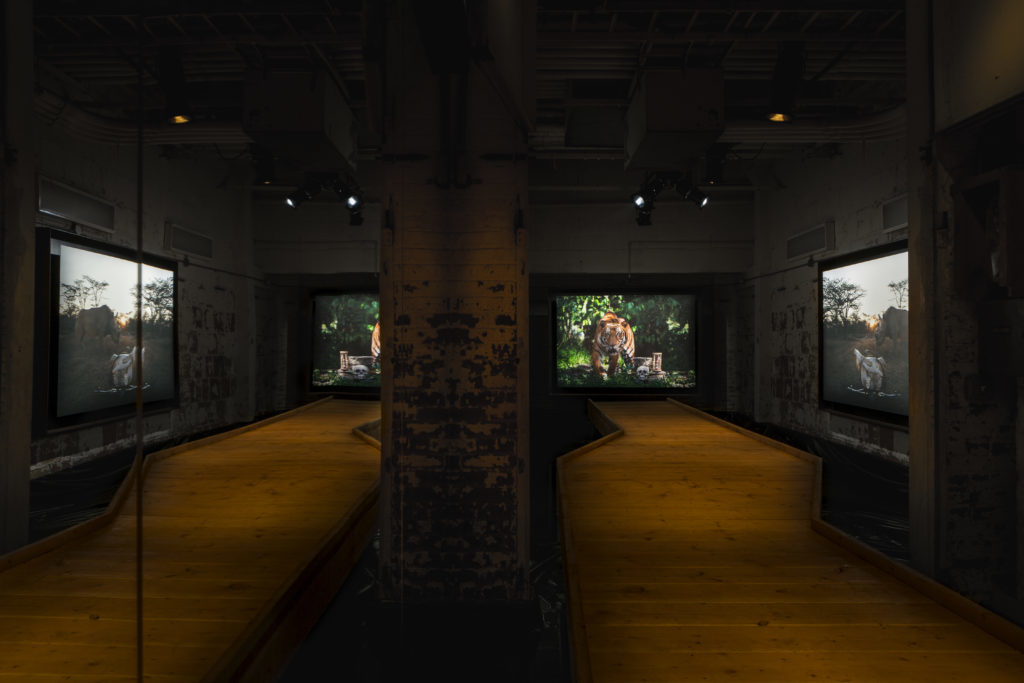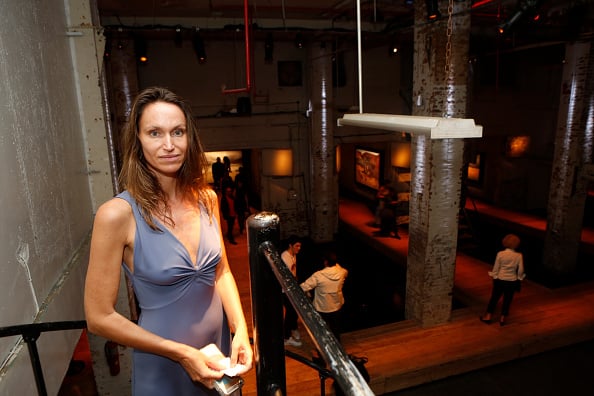People
Anthony Haden-Guest on Anne de Carbuccia and End-of-Species Art
From 'Toxic Waste' in Terra di Fuoci to 'Pollution' in Shanghai, we might be finished.

From 'Toxic Waste' in Terra di Fuoci to 'Pollution' in Shanghai, we might be finished.

There’s a heap of garbage in the foreground of one photograph. We, the viewers, are well on our way up a mountain, and there’s a peak to the rear. I asked Anne de Carbuccia, who had taken the shot, what mountain this was.
“Mount Everest,” she said.
“Oh,” I said.
She took another of the photographs on a game reserve in Kenya. It is centered upon a white rhinoceros, a male called Sudan, who was donated by a zoo in the Czech Republic in the hope that he would breed, which didn’t happen. Sudan is believed to be the last white rhino alive. “He has 83 armed guards and he is guarded 24/7,” de Carbuccia said. “He is the last of his kind. And they still want to kill him.” This deserved another “Oh!”
These photographs are in “One: One Planet One Future,” a show of de Carbuccia’s work at the Westbeth Center for the Arts at 155 Bank in the West Village. Front and center in each is what de Carbuccia calls a Time Shrine, which she has built using whatever materials come to hand, importing just two elements, venerable symbols both, an hourglass and a skull. As much as with the religious and political art of the past, each of de Carbuccia’s pictures is on message, each one tells a story, each is balanced on an edge between hope and despair, and God knows each is a story that urgently needs telling.
It’s a story that became part of Anne de Carbuccia’s life at an early stage. She grew up in the South of France, and her Corsican-born father was the publisher of Jacques Cousteau, the underwater explorer, whose book, The Silent World, was a huge seller and one of the first to focus attention on marine conservation.
“Cousteau is part of my childhood,” de Carbuccia said. “Ferdinand Lallemand, who went on many trips with him, was constantly on holidays with us. And Alain Bombard, who wanted to show people who were shipwrecked how to survive. So he crossed the Atlantic on a little dinghy with no food or water. And my father published the book. So, when I was a little girl, all these strange people would come to my home. It was all about the sea, and adventure. A feeling for nature was ingrained in me.”
An early job of the grown–up Anne was as an art consultant at Drouot, the Paris auction house, where her specialty was 17th and 18th century furniture. “And still life painting was always something that interested me,” she said. “That whole concept of time and vanity.” Hourglasses, human skulls. She married, had two daughters and a son, and settled into an art career, making video portraits, and she travelled compulsively. And she saw changes, as if through Cousteau’s eyes. “I’ve been to places where there are reefs and shark and fish and I would go back and see more plastic garbage than fish on these reefs,” she said.

Anne de Carbuccia attends “ONE: One Planet One Future” at Bank Street Theater on September 13, 2016 in New York City. Photo by Thos Robinson/Getty Images for Time Shrine Foundation.
Just over three years ago, de Carbuccia got into a conversation with Gregory Colbert, a Canadian photographer she had known since they met at the Venice Biennale several years before. Colbert’s best-known work is Ashes and Snow, an ongoing project which traveled with the Nomadic Museum and looks at the shared sensibilities of humans and animals. Colbert, who was off to work in Lake Powell, Utah, made an unusually generous suggestion for an artist, which was that de Carbuccia travel with him and find a project of her own.
They arrived in September 2013. She happened to have brought along an hourglass and a skull. “I created my first Time Shrine at Lake Powell,” she said. “It’s probably America’s best kept secret. It’s a very, very beautiful location between Arizona and Utah. It’s Indian territory and it’s considered one of the biggest water reserves of America.”
They then went to the Amazon. “I just did it,” she said. “It just happened … I think it was an accumulation of all of my life …. there was no specific thought process. Today I can say that I was exorcising my anxiety. I didn’t know that at the beginning. I just did it.” They went on to Antarctica. “I created six installations,” she said, “all over Antarctica. And when I came back and realized that I had a series.”
Anne de Carbuccia first solitary project was a glacier in the Alps she had known when young. “I was very shocked at how much it receded every year. So I went back to it and photographed it,” she said. In all, she has produced eighty images in the last three years, working in every continent, except Australia (no diss, she’ll be there), and these images are grouped according to theme.
She shot an early piece, Toxic Waste, for instance, in Terra di Fuoci, which is close to Naples. “It is called Terra di Fuoci, Land of Fires, because the Mafia for the last thirty or forty years has been burying toxic waste and burning trash from all over the planet there,” she said. “Under the eyes of the entire planet, and nobody has ever done anything about it. Today hens are born with two heads and children die of cancer every day. And it’s twenty minutes outside of Naples. All that stuff is seeping, a lot of it is buried. And it’s going straight into the Mediterranean today. And I always felt a huge sense of injustice for that population.
“It’s a No Man’s Land, it’s quite dangerous, so activists brought me, they are all young guys who have lost friends or family to cancer at a very young age. And it’s still going on today.”
And after that?
“I went to Asia. I did a big Pollution shrine in Shanghai,”
The Chinese gave permission for that?
“No. I just do them. I never ask for permission. I am also a bit of a street artist in my way. I go in, I travel alone. I have a very, very small crew. I will have a translator, but I don’t go in with a crew or anything, So I go in, I create my installation, I work very fast, I photograph it, and then I get out.”
For War she went to the Plain of Jars in Laos. “Laos was never at war, but it is the most bombed place per capita on the planet,” she said. “The Plain of Jars is as ancient as Stonehenge. To this day a hundred people a year die or get maimed by unexploded bombs.”
Drought took her to Nepal.
“Here I am in Upper Mustang. You can only access it by foot or horse, It is the most isolated location in the Himalayas. It’s under the protectorate of Nepal, but this mountain is actually in Tibet. The Himalayans are suffering terribly from drought, which is so absurd when you think about it.”
And all that snow?
“That’s really further up. It’s basically a high-altitude desert.’
For a piece in Refugees, de Carbuccia went to Lampedusa, Sicily, which was teeming with incomers from North Africa. “I went into the boat cemetery, and I took all the pieces of the boats, and I created an installation,” she said.
In this piece, the glass in the hourglass is shattered. A lucky Duchampian accident?
No. “They are out of time, they are dying,” she said.
This broken hourglass, indeed the skulls and hourglasses generally, bring up an art issue: de Carbucccia’s photos are not resonant with postmodern ironies. In her Laos picture, three pythons coil around jars, just as they might have done on a canvas in that deeply unfashionable 19th–century movement, symbolism. It’s a very strong picture.
De Carbuccia observed that a group of collectors had approached her when she was just off to do a shoot at Ladakh, the salt lake in the North of India. They said they would be interested if she could shoot some pictures–minus that skull.
She listened. There are two skulls in the Ladakh picture.
I noted that some believe that nature will bounce back when we’re gone.
“Yes! The planet will survive,” Anne de Carbuccia said. “My question is are we going to survive? What I am fundamentally talking about is the end of the human species.” This surely is where political art should be right now.